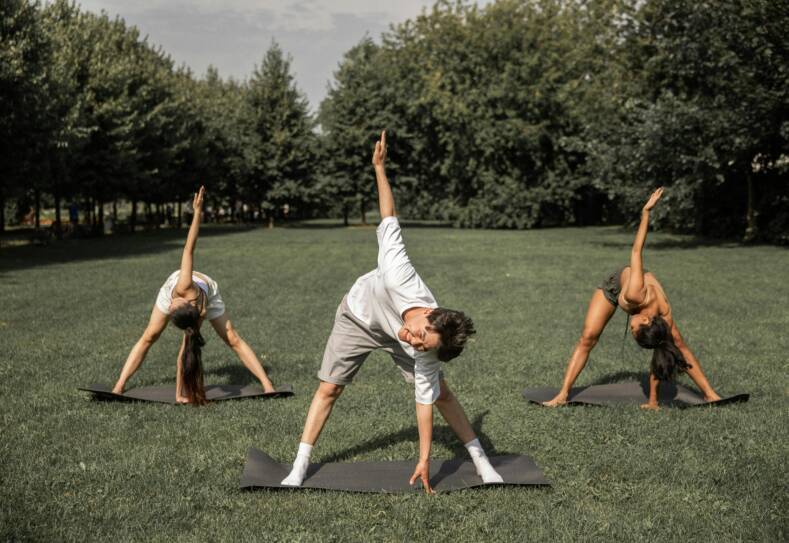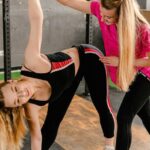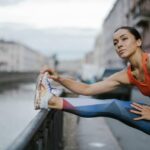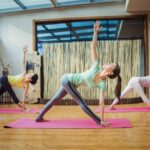Flexibility is an essential component of physical fitness, contributing to the ease of movement and the mitigation of injury risk. It is primarily developed through stretching exercises, which can increase the range of motion in the joints and improve the elasticity of muscles and connective tissues. Stretching routines can be dynamic, involving movement as the stretch is performed, or static, where the stretch is held in a stationary position.
Regularly incorporating flexibility exercises into one’s workout regimen can lead to numerous health benefits. These exercises help maintain the body’s flexibility, which tends to decrease with age and inactivity. By engaging in a planned stretching routine, individuals can enhance their posture, reduce muscle tension, and potentially alleviate the discomfort associated with tight muscles.
Stretching should be performed without bouncing to prevent muscle strain, and stretches should typically be held for about 30 seconds to effectively lengthen the muscle fibers. Beginning with shorter sessions three times a week can provide noticeable improvements in flexibility, and these sessions can be adjusted as one’s flexibility increases. When practiced consistently, flexibility exercises form a vital component of a balanced fitness program, alongside strength, balance, and endurance activities.
Understanding Flexibility
Flexibility refers to the range of motion (ROM) around a joint, which is influenced by the muscles and connective tissues. As individuals age, changes in flexibility can impact health and physical performance.
The Role of Muscles and Joints
Muscles play a vital role in joint flexibility. They act together with ligaments and tendons to allow movement. The degree of flexibility in each joint is determined by several factors including muscle length and joint structure. Joints like the hip, shoulder, and knee have a significant range of motion, enabled by the pliability of the surrounding muscles.
Age-Related Changes in Flexibility
As a person ages, they may experience a decrease in flexibility. This can be attributed to several factors such as reduced muscle mass and changes in connective tissue. Age can make muscles less elastic and joints less mobile. Research indicates that consistent flexibility exercises can mitigate age-related declines in flexibility.
Research on Flexibility and Health
Recent research underscores the benefits of flexibility exercises in promoting overall health and reducing the risk of injury. Stretching activities, which improve flexibility, are shown to decrease discomfort associated with conditions such as chronic low back pain. Additionally, flexibility has been associated with enhanced performance in various physical activities.
Fundamentals of Stretching
Proper stretching is critical for enhancing overall flexibility, optimizing physical performance, and preventing injury. Stretching routines involve targeted movements to loosen the muscles and joints.
Dynamic vs. Static Stretching
Dynamic Stretching involves moving parts of the body in a controlled, gentle, and progressive manner to gradually increase reach, speed of movement, or both. These stretches are generally performed before a workout to mimic the activity that will follow. Examples include leg swings, arm circles, and torso twists.
- Key Points:
- Performed before exercise
- Mimics the activity to follow
- Increases body temperature and blood flow
Static Stretching is characterized by holding a stretch in a challenging yet comfortable position for a period of time, typically between 15 to 60 seconds. This form of stretching is suitable for cooling down after exercises to help muscles relax, realign muscle fibers, and promote flexibility.
- Key Points:
- Held for 15 to 60 seconds
- Done post-exercise
- Promotes muscle relaxation and flexibility
Stretching Techniques
Effective Stretching Techniques require attention to form and proper execution to maximize benefits and minimize the risk of injury. It is essential not to bounce during stretches, as this can cause muscle tears. Each stretching exercise should aim to include the major muscle groups and be conducted in a smooth, deliberate movement.
- Tips:
- Avoid bouncing
- Include major muscle groups
- Use smooth, deliberate movements
Warm-Up and Stretching
Incorporating a Warm-Up before stretching prepares the body for physical exertion and reduces the risk of injuries. A warm-up may consist of light cardiovascular exercises like brisk walking or jogging, and it raises the body temperature to make muscles more pliable for stretching.
- Sequence:
- Begin with light cardio (5-10 minutes)
- Proceed to dynamic stretching
- Perform activity or sport
Injury Prevention through Stretching
Injury Prevention is a significant benefit of regular stretching. By enhancing flexibility and range of motion, stretching exercises prepare muscles and joints for the stresses of other activities. Consistent stretching should be an integral part of any exercise regimen, as it fortifies the body against the common strains and sprains associated with physical activity.
- Prevention Tips:
- Stretch regularly and consistently
- Don’t stretch to the point of pain
- Focus on problem areas without neglecting other muscle groups
By adhering to these fundamentals, individuals can improve their flexibility, prevent injuries, and prepare their bodies for the demands of physical activities.
Designing Your Flexibility Routine
Designing an effective flexibility routine demands consideration of both structure and integration into one’s lifestyle. Here’s how one can create a balanced routine and incorporate flexibility activities daily, supplemented with expert-recommended exercises.
Creating a Balanced Routine
A balanced flexibility routine should target all the major muscle groups including the neck, shoulders, chest, torso, lower back, hips, legs, and ankles.
- Upper Body:
- Neck side stretches
- Shoulder rolls
- Arm swings
- Lower Body:
- Standing quadriceps stretch
- Seated hamstring stretch
- Calf stretches on the edge of a step
Frequency: At least 3 times a week
Duration: Hold each stretch for 15-30 seconds
Repetitions: 2-4 per stretch
Incorporating Flexibility into Daily Activities
One can seamlessly blend stretches into their daily routine to maintain and improve flexibility with little disruption.
- Morning: Incorporate a few minutes of stretching after waking up.
- Work Breaks: Use short breaks to perform desk-based stretches.
- Evening: Wind down with a light yoga or stretching session before bed.
Consistency is key, even if the sessions are short.
Exercise Recommendations from Experts
Fitness experts recommend a variety of stretches to increase flexibility effectively.
- Dynamic Stretches: Perfect for warming up.
- Leg swings
- Arm circles
- Static Stretches: Ideal for cooling down.
- Butterfly stretch for the groin
- Tricep stretch behind the head
- PNF Stretching: For advanced flexibility training.
Complementary Activities: Yoga, Pilates, and Tai Chi enhance flexibility and are recommended for long-term routines.
Target Areas for Flexibility
Flexibility exercises are essential to maintain a full range of motion across various muscle groups. This section explores specific areas to focus on for flexibility training.
Improving Back Flexibility
Back exercises are crucial for good posture and reducing the risk of back pain. Static stretches for the lower back, such as the child’s pose, where one sits back on their heels with arms stretched forward, can increase flexibility. For the upper back, cat-cow stretches, where one alternates between arching and rounding the back while on all fours, help maintain spine health.
Enhancing Shoulder and Chest Flexibility
Shoulders and chest tension can be alleviated with stretches that open up these areas. A popular stretch for the shoulders is the cross-body shoulder stretch, where one arm is brought across the body and gently pulled closer with the opposite hand. For the chest, a simple doorway stretch, where one stands in a doorway with arms on the door frame and gently leans forward, can effectively stretch the chest muscles.
Legs and Hips Flexibility Focus
To increase leg and hip flexibility, a variety of dynamic and static stretches are recommended.
| Muscle Group | Stretches |
|---|---|
| Hamstrings | Seated or standing forward bends gently extend the back of the thighs. |
| Quads | Standing quad stretch where one pulls the foot towards the buttocks. |
| Glutes | Pigeon pose from yoga helps open hip flexors and stretch the gluteal muscles. |
Focusing on these areas can aid in overall mobility and flexibility, essential for both daily activities and athletic performance.
Pain Management and Injury Recovery
In the treatment of pain and enhancement of injury recovery, flexibility exercises play a crucial role. They offer a non-invasive solution that can be tailored to individual needs to manage pain, particularly in the back and joints, and to aid in muscle recovery and rehabilitation.
Dealing with Back Pain and Joint Pain
For individuals suffering from back pain, a strategic, gentle approach to physical activity can foster healing and pain relief. Exercises that specifically target the strengthening and stabilization of core muscles help support the back, potentially reducing instances of pain. For joint pain, low-impact activities such as swimming or cycling maintain joint mobility while minimizing stress on these sensitive areas.
Key exercises for back pain:
- Strengthening core muscles
- Low-impact cardio
Key exercises for joint pain:
- Range-of-motion exercises
- Gentle stretching
Using Stretching for Rehabilitation
Stretching is integral to rehabilitation programs, aiming to improve flexibility and decrease discomfort. After injury, carefully administered stretching aids in maintaining muscle length, reducing the risk of muscle shortening and joint stiffness. Stretching should align with one’s recovery stage and be performed progressively to ensure it supports healing without causing further injury.
Stretching guidelines for rehabilitation:
- Start with gentle stretches
- Progressively increase intensity with recovery
Understanding Muscle Soreness and Recovery
Muscle soreness after exercise is not uncommon and is usually indicative of the muscles rebuilding stronger. This process is essential for recovery and improvement in muscular endurance and strength. However, proper muscle recovery necessitates rest and appropriate nutrition to replenish energy stores and allow for tissue repair. Individuals should listen to their bodies and adjust activity levels to their recovery needs.
Tips for muscle recovery:
- Adequate rest
- Balanced nutrition
- Hydration
Muscle recovery essentials:
- Rest: Critical for repair and strengthening
- Nutrition: Provides building blocks for muscle tissue
- Hydration: Ensures essential bodily functions support recovery
Advanced Flexibility Techniques
Advanced flexibility techniques are integral for both enhancing range of motion and supporting athletic performance. These methods often incorporate structured programs such as yoga and Pilates, and focus on specific training protocols like myofascial release and active isolated stretching to improve overall flexibility.
Yoga and Pilates for Flexibility
Yoga and Pilates are sophisticated systems that not only heighten flexibility but also strengthen the body. Yoga’s diverse poses, known as asanas, consistently challenge and expand one’s flexibility thresholds. Iyengar Yoga, for instance, emphasizes alignment and precision, often using props to deepen the stretch and improve posture. Pilates, with its core-centric exercises, improves muscular elasticity and joint mobility, promoting functional flexibility that transfers to daily activities.
Athletic Performance and Flexibility Training
For athletes, flexibility training is crucial in optimizing athletic performance. Techniques such as active isolated stretching (AIS) allow them to target specific muscle groups effectively. AIS involves extending a muscle for two seconds at a time, which can lead to enhancements in both dynamic flexibility and muscular performance. This facet of flexibility training not only improves range of motion but also assists with injury prevention, making it a key component of any serious athlete’s regimen.
- Key Athletic Benefits:
- Enhances range of motion
- Reduces injury risk
- Improves muscle performance
Innovative Stretching Methods
Adopting innovative stretching methods can lead to significant improvements in flexibility. One such method is myofascial release, which focuses on relieving muscular tightness by releasing the fascia. Tools like foam rollers and massage balls are often employed to apply targeted pressure to muscle tissue, freeing restrictions and promoting blood flow. Another advanced technique, PNF stretching or proprioceptive neuromuscular facilitation, involves both stretching and contracting the muscle group being targeted.
- Techniques:
- Myofascial Release
- Foam Rolling
- Massage Balls
- PNF Stretching
- Myofascial Release
By integrating these advanced techniques, individuals can enhance their flexibility significantly, which contributes to better movement quality in both fitness and daily life.
The Psychological Benefits of Stretching
Incorporating stretching into one’s exercise routine extends beyond physical flexibility; it also offers valuable psychological advantages. Specifically, stretching can be a catalyst for stress relief and can complement the broader connection between mental health and physical activity.
Stretching for Stress Relief and Relaxation
- Stress Relief: Incorporating static stretches, where positions are held for around 15-30 seconds, can induce a state of calmness. By focusing on the activity and maintaining deep, rhythmic breaths, individuals often experience a release of tension within their muscles. This relaxation response can help lower the body’s stress levels.
- Relaxation Techniques: Mindful stretching activities, such as yoga poses like cobra and downward dog, integrate the principles of mindfulness with physical movement. This combination encourages a restful state of mind which aids in the dissipation of stress and promotes relaxation.
The Connection Between Mental Health and Physical Activity
- Enhanced Mental Health: Regular participation in physical activities, including stretching exercises, has been linked to improvements in various aspects of mental health. When individuals engage their bodies in physical exercise, they may see reductions in symptoms of anxiety and depression, along with enhanced self-esteem and confidence.
- Psychological Flexibility: Just as dynamic stretching increases the physical range of motion, psychological flexibility—a concept that reflects one’s adaptability to changing situations—can improve through regular physical activity. The discipline and focus required in stretching exercises can foster a mental resilience that is transferable to other life challenges.
By intertwining regular stretching routines with mental health strategies, individuals can not only enhance their physical flexibility but also develop coping mechanisms that contribute to a more stress-resistant and mentally robust disposition.
Safeguarding Your Health and Flexibility
To maintain and enhance flexibility, one should approach the practice with a diligent understanding of their unique health needs and limits. This section covers the importance of seeking medical advice and creating individualized stretching routines to promote safe and effective flexibility training.
Consulting Health Professionals
Before beginning any new flexibility exercises, individuals are recommended to consult with a health professional, such as a doctor or physical therapist. These experts can assess one’s health status and identify any potential risks associated with certain stretches. They are equipped to offer health tips and guidelines tailored to an individual’s conditions, like chronic illnesses or previous injuries, ensuring the safety and efficacy of their flexibility training.
Personalized Stretching Plans and Precautions
Creating a personalized stretching plan involves identifying exercises that specifically target one’s muscles and joints while considering any existing health concerns. A physical therapist can provide insight into which stretches are most beneficial and which should be avoided. When managing health and flexibility, it’s critical to:
- Start slowly, with gentle stretches, to warm up muscles
- Progress to more advanced stretches as flexibility and comfort increase
- Use proper form to prevent injury
- Listen to one’s body and stop if a stretch causes pain
These precautions help in achieving a safe and gradual improvement in flexibility without sacrificing one’s health.








